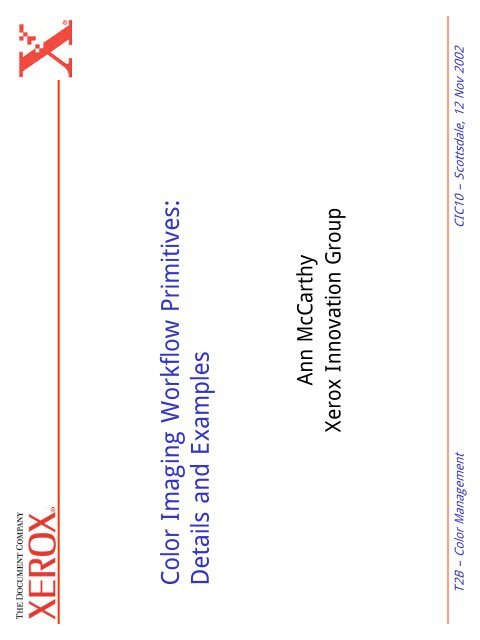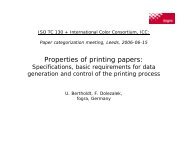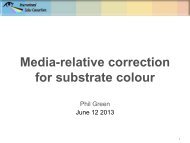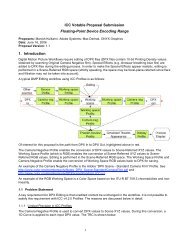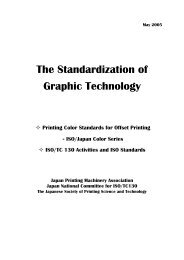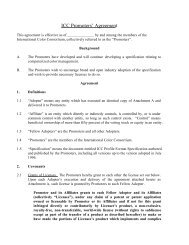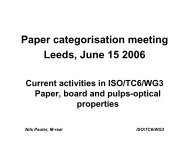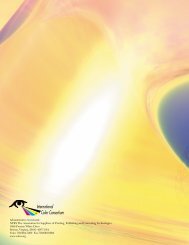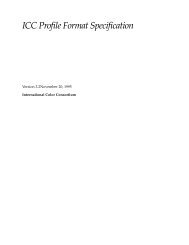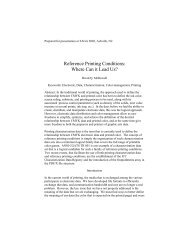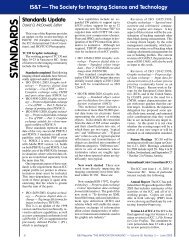Color Imaging Workflow Primitives: Details and Examples
Color Imaging Workflow Primitives: Details and Examples
Color Imaging Workflow Primitives: Details and Examples
You also want an ePaper? Increase the reach of your titles
YUMPU automatically turns print PDFs into web optimized ePapers that Google loves.
<strong>Color</strong> <strong>Imaging</strong> <strong>Workflow</strong> <strong>Primitives</strong>:<br />
<strong>Details</strong> <strong>and</strong> <strong>Examples</strong><br />
Ann McCarthy<br />
Xerox Innovation Group<br />
T2B – <strong>Color</strong> Management CIC10 – Scottsdale, 12 Nov 2002
<strong>Color</strong> Fidelity<br />
The term “color fidelity” refers to the successful<br />
interoperability of color data, from image<br />
creation to output across multiple targets, such<br />
that color reproduction quality consistent with<br />
the user’s intent can be achieved<br />
Note: Interoperability among system color components,<br />
necessary for color fidelity, is both color-workflow <strong>and</strong><br />
market-segment dependent<br />
T2B - <strong>Color</strong> Management A. McCarthy CIC10 - Scottsdale, 12 Nov 2002<br />
2
Let’s define our terms…<br />
definitions for architecture, image state,<br />
<strong>and</strong> image processing<br />
T2B - <strong>Color</strong> Management A. McCarthy CIC10 - Scottsdale, 12 Nov 2002<br />
3
<strong>Color</strong> Control (ICC) Architecture Elements<br />
• Device calibration<br />
• Alters the color response of a device to return it to a known state<br />
• Capture <strong>and</strong> visualization characterization<br />
• Describes the color response of an input or output condition<br />
• Profile creation<br />
• Encodes a characterization <strong>and</strong> a color aim for use in a transform<br />
<strong>Color</strong> Source Specification<br />
• Image color encoding<br />
• Unrendered (e.g., capture a scene) vs. color-rendered (targeted)<br />
<strong>Color</strong> Communication<br />
• Profile selection <strong>and</strong> exchange<br />
• Profiles can be embedded with an image or document, or can be<br />
transmitted as separate files<br />
• Profile use<br />
<strong>Color</strong> Calibration<br />
<strong>Color</strong> Aim Implementation<br />
<strong>Color</strong> Transformation<br />
• Profiles are applied in pairs to transform an image from a current<br />
encoding (the source) to another encoding (the destination)<br />
• Visualization – the human element<br />
• What does the human expect?<br />
<strong>Color</strong> Aim Expectation<br />
T2B - <strong>Color</strong> Management A. McCarthy CIC10 - Scottsdale, 12 Nov 2002<br />
4<br />
<strong>Color</strong> Characterization
<strong>Color</strong> Control (ICC) Architecture<br />
• ICC color management can be used to front-load color<br />
knowledge <strong>and</strong> color preference into a workflow ‘setup’<br />
• <strong>Workflow</strong> elements are distributed over time <strong>and</strong><br />
location<br />
• <strong>Workflow</strong> elements are created by multiple vendors<br />
• In such a distributed, multi-vendor system, interface<br />
definitions between the components are critical<br />
• Data definitions<br />
• Behavior definitions<br />
• The ICC provides those definitions<br />
• Currently, the ICC specifies the data exchange format<br />
of the color transform metadata<br />
• In addition, the ICC specifies a limited set of profile<br />
“interpretation” rules recommending CMM behavior<br />
5<br />
T2B - <strong>Color</strong> Management A. McCarthy CIC10 - Scottsdale, 12 Nov 2002
Definitions<br />
• Image state<br />
• The degree to which image data has been constrained or<br />
purposed to a particular visualization mechanism, as compared<br />
to the degree to which the image data has been retained<br />
unaltered with respect to its capture condition<br />
Concepts of scenereferred,<br />
originalreferred,<br />
<strong>and</strong> outputreferred<br />
image state as<br />
shown in ISO CD<br />
22028-1-Part 1<br />
ICC workflows include<br />
both Actual Output<br />
Referred (a particular<br />
visualization device) <strong>and</strong><br />
Reference Output<br />
Referred (e.g., SWOP)<br />
T2B - <strong>Color</strong> Management A. McCarthy CIC10 - Scottsdale, 12 Nov 2002<br />
6
Definitions<br />
• ‘Scene-Referred image data’ (SR)<br />
• Image data that unambiguously encodes the spectral reflectances of<br />
the scene (including scene-capture tristimulus encodings)<br />
• A scene-referred image would be encoded using a very large gamut,<br />
high dynamic range color encoding specification<br />
• ‘Original-Referred image data’ (OR)<br />
The idea of image state is intended to be<br />
• Image data useful that unambiguously in thinking about encodes two concerns: a captured computer-<br />
1.“What processing has been applied to this image?”<br />
2.“How should I sequence my workflow to maximize<br />
color fidelity?”<br />
• Output-referred image data that is color-rendered to a st<strong>and</strong>ardized<br />
(i.e., minimize the need to estimate colors)?<br />
generated or hardcopy original<br />
• 'Reference-Output-Referred image data' (ROR)<br />
output (i.e., an output that is defined through an ideal specification -<br />
a precise, arbitrary, output definition that may or may not be<br />
realizable)<br />
• 'Actual-Output-Referred image data' (AOR)<br />
• Output-referred image data that is color-rendered to a specific,<br />
particular, realizable device, e.g., encoding the intended color<br />
appearance of an image as it is to be printed to a particular printer<br />
T2B - <strong>Color</strong> Management A. McCarthy CIC10 - Scottsdale, 12 Nov 2002<br />
7
Definitions<br />
• ‘Scene-Referred image data’ (SR)<br />
• Image data that unambiguously encodes the spectral reflectances of<br />
the scene (including scene-capture tristimulus encodings)<br />
• A scene-referred image would be encoded using a very large gamut,<br />
high dynamic range color encoding specification<br />
• ‘Original-Referred image data’ (OR)<br />
• Image data that unambiguously encodes a captured computergenerated<br />
or hardcopy original<br />
• 'Reference-Output-Referred image data' (ROR)<br />
• Output-referred image data that is color-rendered to a st<strong>and</strong>ardized<br />
output (i.e., an output that is defined through an ideal specification -<br />
a precise, arbitrary, output definition that may or may not be<br />
realizable)<br />
• 'Actual-Output-Referred image data' (AOR)<br />
• Output-referred image data that is color-rendered to a specific,<br />
particular, realizable device, e.g., encoding the intended color<br />
appearance of an image as it is to be printed to a particular printer<br />
T2B - <strong>Color</strong> Management A. McCarthy CIC10 - Scottsdale, 12 Nov 2002<br />
8
Definitions<br />
• The wide range of particular scene-referred instances,<br />
original-referred instances, reference-output-referred<br />
instances, <strong>and</strong> actual-output-referred instances are<br />
coalesced into these four meta-image-states, allowing the<br />
establishment of an overarching set of "workflow rules"<br />
governing the relationships between these image states:<br />
• Capture occurs into either the scene-referred state or the originalreferred<br />
image state - i.e., a capture-referred state<br />
• Image data must be “color-rendered" to an actual-output-referred<br />
color encoding specification before it can be visualized through any<br />
output mechanism<br />
• A reference-output-referred image can be used as a st<strong>and</strong>ardized<br />
exchange of expected or preferred output color appearance, but<br />
may or may not be directly physically realizable<br />
• Device dependent color encodings that are not associated with any<br />
ICC profile or means of converting to CIE colorimetry (thereby<br />
achieving device independence) cannot be color managed<br />
T2B - <strong>Color</strong> Management A. McCarthy CIC10 - Scottsdale, 12 Nov 2002<br />
9
Definitions<br />
• <strong>Workflow</strong> permutations<br />
• RGB workflow<br />
• RGB encoding is retained <strong>and</strong> exchanged<br />
• RGB can be ‘visualization constrained’ output-referred (e.g., sRGB) or<br />
capture-referred (calibrated digital camera RGB, calibrated scanner RGB)<br />
• CMYK workflow<br />
• CMYK ‘visualization constrained’ encoding is retained <strong>and</strong> exchanged<br />
• CMYK can be actual-output-referred<br />
• CMYK can be reference-output-referred<br />
• Re-targeting<br />
• Maintaining image colorimetry while changing device code values to<br />
customize to a particular device of the same or larger gamut<br />
– CMYK black channel preservation may or may not be included<br />
• Proofing a final visualization to an intermediate device can be successful<br />
to the degree that the proofing device gamut is larger or equal<br />
• Re-purposing<br />
• Re-color-rendering data that has been color-rendered for a particular<br />
output gamut to a different output gamut<br />
T2B - <strong>Color</strong> Management A. McCarthy CIC10 - Scottsdale, 12 Nov 2002<br />
10
Definitions<br />
• Four fundamental image processing operations<br />
• Correction operations:<br />
• ‘Corrections’ are operations that are required based on device<br />
limitations or anomalies<br />
• 'Corrections' can be capture side image specific adjustments<br />
that prepare an image so that it can then be processed<br />
through gamut mapping operations, appearance operations,<br />
<strong>and</strong>/or preference operations in different ways for different<br />
output options<br />
• Capture correction operations can be image <strong>and</strong> capture<br />
method specific <strong>and</strong> should precede color-rendering<br />
operations<br />
• Correction operations can also occur at the final stage of<br />
output, within the output device (e.g., output device<br />
calibration)<br />
• Output correction operations are device specific, <strong>and</strong> are the<br />
responsibility of the output device<br />
T2B - <strong>Color</strong> Management A. McCarthy CIC10 - Scottsdale, 12 Nov 2002<br />
11
Definitions<br />
• Four fundamental image processing operations<br />
• Appearance operations:<br />
• Appearance operations are input to output environment<br />
specific operations<br />
• <strong>Examples</strong> are<br />
– Lightening or dynamic range compression to compensate<br />
for illumination level <strong>and</strong> surround differences<br />
– Unsharp masking to maintain detail contrast<br />
• Depending on the particular situation, a preference or gamut<br />
mapping algorithm might operate prior to or following an<br />
appearance operation<br />
12<br />
T2B - <strong>Color</strong> Management A. McCarthy CIC10 - Scottsdale, 12 Nov 2002
Definitions<br />
• Four fundamental image processing operations<br />
• Preference operations:<br />
• Preference operations are image specific <strong>and</strong> may be output<br />
gamut constrained<br />
• Preference issues deal with intentional alterations of<br />
appearance to increase the aesthetic value of an image<br />
• The preference may pertain to a particular visualization<br />
– Applied in an output-referred image state<br />
• The preference may pertain to all visualizations<br />
– Applied in a capture-referred image state<br />
• <strong>Examples</strong><br />
– Sharpening <strong>and</strong> contrast boosting<br />
– Selecting a saturated green grass that you know is actually<br />
within a targeted output gamut ⇒ output constrained<br />
preference adjustment<br />
– Preference operations may be part of a color-rendering<br />
operation or may be distinct<br />
T2B - <strong>Color</strong> Management A. McCarthy CIC10 - Scottsdale, 12 Nov 2002<br />
13
Definitions<br />
• Four fundamental image processing operations<br />
• Gamut mapping operations:<br />
• Gamut mapping operations are input to output specific<br />
– Mapping the co-ordinates of the elements of a source<br />
image to the co-ordinates of the corresponding elements of<br />
a reproduction<br />
– Compensating for differences in the source <strong>and</strong> output<br />
color gamut volume <strong>and</strong> shape<br />
– E.g., Perceptual PCS to visualization output gamut<br />
• Gamut mapping operations fit the results of appearance <strong>and</strong><br />
preference operations into actual device/medium gamuts<br />
– Ideally providing best results when the operation is image<br />
specific<br />
• The term 'gamut mapping' includes the simple case of clipping<br />
at the gamut boundary as must occur when going from a<br />
larger gamut to a smaller gamut even in the media-relative<br />
colorimetric Rendering Intent case<br />
T2B - <strong>Color</strong> Management A. McCarthy CIC10 - Scottsdale, 12 Nov 2002<br />
14
The workflow primitives…<br />
15<br />
workflow building blocks <strong>and</strong> descriptions<br />
T2B - <strong>Color</strong> Management A. McCarthy CIC10 - Scottsdale, 12 Nov 2002
Functional <strong>Workflow</strong> <strong>Primitives</strong><br />
• Capture<br />
• Device correction operations<br />
• Process control stability<br />
• Digitized format <strong>and</strong> data are<br />
device dependent <strong>and</strong><br />
manufacturer controlled<br />
• <strong>Color</strong>-Render (CMM)<br />
• Appearance <strong>and</strong> gamut mapping<br />
operations - input to output<br />
• Apply capture specific<br />
characterization transform<br />
• Apply ‘reference’ color space<br />
encoding transforms<br />
• Apply visualization condition<br />
specific transforms<br />
• Scum dot elimination<br />
• Separation⇔gamut interactions<br />
Identify the workflow primitives<br />
that are the building blocks of every workflow.<br />
Describe those workflow primitives <strong>and</strong> differentiate<br />
them from each other.<br />
Use these 'normalized' building blocks<br />
to represent real world workflows.<br />
T2B - <strong>Color</strong> Management A. McCarthy CIC10 - Scottsdale, 12 Nov 2002<br />
16<br />
• Adjust image/object<br />
• Apply image preferences<br />
• Preference operations are<br />
arbitrary & use specific<br />
• Assemble object/entity<br />
• Combination of objects<br />
• Control of job information<br />
• Visualize<br />
• Device correction operations<br />
• Manufacturer controlled<br />
• Process control stability<br />
• Includes halftoning, trapping<br />
• Can include black channel<br />
• UCR/GCR, black-only<br />
• Overprint/knockout<br />
• Display the assembled entity
Functional <strong>Workflow</strong> <strong>Primitives</strong><br />
• Capture<br />
• Device correction operations<br />
• Process control stability<br />
• Digitized format <strong>and</strong> data are<br />
device dependent <strong>and</strong><br />
manufacturer controlled<br />
• <strong>Color</strong>-Render (CMM)<br />
• Appearance <strong>and</strong> gamut mapping<br />
operations - input to output<br />
• Apply capture specific<br />
characterization transform<br />
• Apply ‘reference’ color space<br />
encoding transforms<br />
• Apply visualization condition<br />
specific transforms<br />
• Scum dot elimination<br />
• Separation⇔gamut interactions<br />
• Adjust image/object<br />
What is that proprietary<br />
function that h<strong>and</strong>les<br />
digitization?<br />
• Apply image preferences<br />
• Preference operations are<br />
arbitrary & use specific<br />
• Assemble object/entity<br />
What is the “primitive”<br />
functionality of a CMM?<br />
• Combination of objects<br />
• Control of job information<br />
• Visualize<br />
T2B - <strong>Color</strong> Management A. McCarthy CIC10 - Scottsdale, 12 Nov 2002<br />
17<br />
• Device correction operations<br />
• Manufacturer controlled<br />
• Process control stability<br />
• Includes halftoning, trapping<br />
• Can include black channel<br />
• UCR/GCR, black-only<br />
• Overprint/knockout<br />
• Display the assembled entity
Functional <strong>Workflow</strong> <strong>Primitives</strong><br />
• Capture<br />
How do we factor in to the<br />
workflow the image edits<br />
that people want to do to<br />
improve their images?<br />
• Device correction operations<br />
• Process control stability<br />
• Digitized format <strong>and</strong> data are<br />
device dependent <strong>and</strong><br />
manufacturer controlled<br />
In many workflows,<br />
probably all workflows in<br />
the commercial world, we<br />
need to combine images,<br />
text, <strong>and</strong> vector…<br />
…<strong>and</strong> we need to keep<br />
track of all of the data <strong>and</strong><br />
metadata in a “job.”<br />
• <strong>Color</strong>-Render (CMM)<br />
• Appearance <strong>and</strong> gamut mapping<br />
operations - input to output<br />
• Apply capture specific<br />
characterization transform<br />
• Apply ‘reference’ color space<br />
encoding transforms<br />
• Apply visualization condition<br />
specific transforms<br />
• Scum dot elimination<br />
What is the<br />
proprietary<br />
function that<br />
h<strong>and</strong>les display?<br />
• Separation⇔gamut interactions<br />
T2B - <strong>Color</strong> Management A. McCarthy CIC10 - Scottsdale, 12 Nov 2002<br />
18<br />
• Adjust image/object<br />
• Apply image preferences<br />
• Preference operations are<br />
arbitrary & use specific<br />
• Assemble object/entity<br />
• Combination of objects<br />
• Control of job information<br />
• Visualize<br />
• Device correction operations<br />
• Manufacturer controlled<br />
• Process control stability<br />
• Includes halftoning, trapping<br />
• Can include black channel<br />
• UCR/GCR, black-only<br />
• Overprint/knockout<br />
• Display the assembled entity
The Capture <strong>Workflow</strong> Primitive<br />
Scene<br />
reflectances,<br />
Original<br />
images<br />
Fundamental <strong>Imaging</strong> Operation:<br />
1. Device correction<br />
Key <strong>Color</strong> Fidelity Requirements:<br />
1. Process control stability<br />
2. Transform proprietary<br />
device-dependent raw<br />
capture data to a deviceindependent<br />
representation<br />
Image State Impact:<br />
1. Initialize image state<br />
based on capture<br />
conditions<br />
Image System Domain:<br />
1. Proprietary methods<br />
2. St<strong>and</strong>ard output format<br />
Scenereferred,<br />
Originalreferred<br />
T2B - <strong>Color</strong> Management A. McCarthy CIC10 - Scottsdale, 12 Nov 2002<br />
19
The Capture <strong>Workflow</strong> Primitive<br />
• Capture Scene<br />
• Image state is initialized to scene-referred<br />
• Capture scene-referred images from a digital camera or from a<br />
scan of a negative<br />
• Process to correct for capture device, e.g., gray balance <strong>and</strong><br />
intensity adjustment<br />
• Data is not color-rendered to any visualization, i.e., an ICC<br />
profile is associated but not applied<br />
• Scene capture refers to capture of the spectral radiances of a<br />
view of the natural world <strong>and</strong> may also include capture of a<br />
computer simulation of such spectral radiances<br />
• The Capture Scene primitive produces scene-referred images<br />
- each with an associated input profile - characterizing the<br />
capture condition (negative scanner, digital camera)<br />
20<br />
T2B - <strong>Color</strong> Management A. McCarthy CIC10 - Scottsdale, 12 Nov 2002
The Capture <strong>Workflow</strong> Primitive<br />
• Capture Original<br />
• Image state is initialized to original-referred<br />
• Capture reflection or transparency color-rendered images, scan from<br />
reflection hardcopy (e.g., artwork), or scan from positive<br />
transparency; or capture color-rendered computer generated image<br />
• Process to correct for capture device, e.g., gray balance <strong>and</strong> intensity<br />
• The original-referred image data contains color-rendering to the output<br />
gamut of the process that created the original hardcopy<br />
• This case includes color-rendered computer graphics images: image<br />
data created through computer graphics application that is rendered<br />
to an image look <strong>and</strong> is original-referred to the creation station<br />
• Computer generated color-rendered images may be rendered to the<br />
gamut of the creation display, or rendered to a print softcopy<br />
• The Capture Original primitive produces original-referred images<br />
- each with an associated input profile - characterizing the capture<br />
condition (e.g., reflection scanner, positive transparency scanner,<br />
computer graphics workstation monitor) - the profiles are not applied<br />
21<br />
T2B - <strong>Color</strong> Management A. McCarthy CIC10 - Scottsdale, 12 Nov 2002
The <strong>Color</strong>-Render (CMM) <strong>Workflow</strong> Primitive<br />
Capturereferred,<br />
Outputreferred<br />
Fundamental <strong>Imaging</strong> Operations:<br />
1. Gamut mapping <strong>and</strong><br />
appearance operations<br />
2. Preference operation<br />
Key <strong>Color</strong> Fidelity Requirements:<br />
1. Process characterization<br />
2. Transform a source<br />
device-independent<br />
representation to a<br />
destination deviceindependent<br />
representation<br />
Image State Impact:<br />
1. Change or ‘nest’ image<br />
state based on colorrender<br />
condition<br />
Image System Domain:<br />
1. St<strong>and</strong>ard format interface<br />
2. St<strong>and</strong>ard media-relative<br />
colorimetric methods<br />
3. Proprietary perceptual<br />
methods<br />
Applied<br />
rendering,<br />
Virtual<br />
rendering<br />
T2B - <strong>Color</strong> Management A. McCarthy CIC10 - Scottsdale, 12 Nov 2002<br />
22
The <strong>Color</strong>-Render (CMM) <strong>Workflow</strong> Primitive<br />
• <strong>Color</strong>-Render CHANGES IMAGE STATE<br />
• <strong>Color</strong>-Render includes profile based gamut mapping <strong>and</strong><br />
manual adjustments to correct gamut mapping<br />
• <strong>Color</strong>-Render includes gamut to gamut transform, e.g.,<br />
CMYK to CMYK, sRGB to monitor RGB transform, within the<br />
same meta-image-state<br />
• <strong>Color</strong>-Render includes appearance (viewing environment)<br />
adaptation <strong>and</strong> preferential aspects of the perceptual intent<br />
• <strong>Color</strong>-Render may occur ONE or N TIMES<br />
• Following Capture<br />
• Before Adjust Image/Object<br />
• Following Adjust Image/Object<br />
• As a substep of Assemble Object/Entity<br />
• After Assemble Object/Entity<br />
• As a substep of Visualization<br />
• Using Visualization (manual color-rendering)<br />
T2B - <strong>Color</strong> Management A. McCarthy CIC10 - Scottsdale, 12 Nov 2002<br />
23
The <strong>Color</strong>-Render (CMM) <strong>Workflow</strong> Primitive<br />
• Gamut mapping <strong>and</strong> appearance mapping are carried out in<br />
combination between a source profile, a destination profile,<br />
<strong>and</strong> a color management module (CMM)<br />
• Both gamut mapping <strong>and</strong> appearance adaptation are built<br />
into the perceptual transforms of source <strong>and</strong> destination<br />
profiles<br />
• Chromatic adaptation is built into media-relative colorimetric<br />
intent transforms<br />
• A CMM h<strong>and</strong>les clipping to the destination gamut boundary<br />
as required for the media-relative colorimetric intent<br />
• A CMM should h<strong>and</strong>le certain gamut mapping cases<br />
• E.g., for perceptual, media-relative colorimetric, <strong>and</strong> saturation<br />
intents, white should NEVER be interpolated<br />
• 255r,255g,255b should always convert to non-image/non-ink values<br />
(255,255,255 for RGB <strong>and</strong> 0,0,0,0 for CMYK)<br />
24<br />
T2B - <strong>Color</strong> Management A. McCarthy CIC10 - Scottsdale, 12 Nov 2002
The <strong>Color</strong>-Render (CMM) <strong>Workflow</strong> Primitive<br />
• ‘Virtual color-rendering’ can be used to assign a visualization<br />
for later use<br />
⇒ Producing images with an associated (but not applied) Visualization Condition<br />
(ICC Profile), e.g., “Virtual CMYK”<br />
<strong>Examples</strong><br />
• SR Data + Input Profile ⇒ SR Data + Input Profile + Output Profile(s)**<br />
• OR Data + Input Profile ⇒ OR Data + Input Profile + Output Profile(s)**<br />
• ROR Data + Source Profile ⇒ ROR Data + Source Profile + Output Profile(s)**<br />
• AOR Data + Source Profile ⇒ AOR Data + Source Profile + Output Profile(s)**<br />
**optional additional Output Profile to h<strong>and</strong>le proofing, image setter, etc.<br />
The 2nd or additional output profile would be chained following the input<br />
<strong>and</strong> primary output profiles when the image data is processed for the<br />
proofer, imagesetter, etc.<br />
• ‘Applied color-rendering’ can be used to process image data<br />
through a source profile <strong>and</strong> one or more destination profiles<br />
⇒ Producing images realized in a Visualization Condition (output-referred state)<br />
<strong>Examples</strong><br />
• SR Data + Input Profile ⇒ AOR or ROR Data + Source Profile<br />
• OR Data + Input Profile ⇒ ROR or AOR Data + Source Profile<br />
• ROR or AOR Data + Source Profile ⇒ a different ROR or AOR Data + Source Profile<br />
T2B - <strong>Color</strong> Management A. McCarthy CIC10 - Scottsdale, 12 Nov 2002<br />
25
The <strong>Color</strong>-Render (CMM) <strong>Workflow</strong> Primitive<br />
• ‘Virtual color-rendering’ can be used to assign a visualization<br />
for later use<br />
⇒ Producing images with an associated (but not applied) Visualization Condition<br />
(ICC Profile), e.g., “Virtual CMYK”<br />
<strong>Examples</strong><br />
Note that in a Version 4 Input profile –<br />
• SR Data + Input Profile the media-relative ⇒ SR Data + colorimetric Input Profile rendering + Output intent Profile(s)**<br />
• OR Data + Input Profile portrays ⇒ OR a Data capture-referred + Input Profile image + Output into the Profile(s)**<br />
• ROR Data + Source <strong>Color</strong>imetric Profile ⇒ ROR PCS Data – in + this Source case a Profile <strong>Color</strong>-Render + Output Profile(s)**<br />
• AOR Data + Source transform Profile ⇒ is AOR applied Data (chromatic + Source adaptation, Profile + Output white Profile(s)**<br />
**optional additional point mapping)- Output Profile but the to image h<strong>and</strong>le does proofing, not become image setter, etc.<br />
The 2nd or additional output "output-referred"<br />
profile would be chained following the input<br />
<strong>and</strong> primary …so output in this profiles case when managing the image the display data is image processed state is for the<br />
up to the destination profile.<br />
proofer, imagesetter, etc.<br />
• ‘Applied color-rendering’ can be used to process image data<br />
through a source profile <strong>and</strong> one or more destination profiles<br />
⇒ Producing images realized in a Visualization Condition (output-referred state)<br />
<strong>Examples</strong><br />
• SR Data + Input Profile ⇒ AOR or ROR Data + Source Profile<br />
• OR Data + Input Profile ⇒ ROR or AOR Data + Source Profile<br />
• ROR or AOR Data + Source Profile ⇒ a different ROR or AOR Data + Source Profile<br />
T2B - <strong>Color</strong> Management A. McCarthy CIC10 - Scottsdale, 12 Nov 2002<br />
26
The Adjust Image/Object <strong>Workflow</strong> Primitive<br />
Fundamental <strong>Imaging</strong> Operation:<br />
1. Preference operation<br />
Key <strong>Color</strong> Fidelity Requirements:<br />
1. Proprietary methods<br />
estimate expected<br />
visualization conditions<br />
2. Transform an initial<br />
representation into an<br />
‘expected visualization’<br />
preferred representation<br />
Image State Impact:<br />
1. Persist image state<br />
2. Same-state appearance<br />
changes are encoded in<br />
image or metadata<br />
Image System Domain:<br />
1. St<strong>and</strong>ard format interface<br />
2. Proprietary methods<br />
Capturereferred,<br />
Outputreferred<br />
Capturereferred,<br />
Outputreferred<br />
T2B - <strong>Color</strong> Management A. McCarthy CIC10 - Scottsdale, 12 Nov 2002<br />
27
The Adjust Image/Object <strong>Workflow</strong> Primitive<br />
• Adjust deals with preference <strong>and</strong> aesthetic changes, not<br />
changes required due to constraints imposed by any<br />
particular visualization mechanism<br />
• Adjust does NOT change image state<br />
• Adjust DOES change encoded values<br />
• Adjust does not change image or assembled object file formats<br />
• Adjust includes local <strong>and</strong>/or global preference operations<br />
• Adjust may occur ONE or N TIMES<br />
• Following Capture<br />
• Before <strong>Color</strong>-Render<br />
• Following <strong>Color</strong>-Render<br />
• As a substep of Assemble Object/Entity<br />
• As a substep of Visualization<br />
• Using Visualization<br />
• Global preference changes may be accomplished by<br />
adjusting a profile<br />
T2B - <strong>Color</strong> Management A. McCarthy CIC10 - Scottsdale, 12 Nov 2002<br />
28
The Adjust Image/Object <strong>Workflow</strong> Primitive<br />
• Directly Preference adjust image data<br />
• Any associated profile(s) are carried along but not changed<br />
• This method will support local changes as well as global changes<br />
in the image data<br />
• Optionally, adjust image data while viewing through the<br />
associated input/source profile, or the concatenated<br />
input/source <strong>and</strong> destination profiles<br />
• Adjust image data while viewing through the available profile(s)<br />
to get the desired real or virtual output appearance <strong>and</strong> to<br />
ensure that the preference adjustments are compatible with<br />
profile-based color-renderings<br />
29<br />
T2B - <strong>Color</strong> Management A. McCarthy CIC10 - Scottsdale, 12 Nov 2002
The Adjust Image/Object <strong>Workflow</strong> Primitive<br />
• Preference adjust the perceptual intent of the input/source<br />
profile associated with an image<br />
• While viewing the (capture-referred or reference-output-referred)<br />
image through the input/source profile <strong>and</strong>, if a destination profile<br />
is associated, while also viewing it through the destination profile<br />
• The edits are applied to the perceptual intent transform of the<br />
input/source profile <strong>and</strong> the viewing is through the perceptual<br />
intent transform(s) of the associated profile(s)<br />
• This method allows only global changes using the current ICC<br />
paradigm<br />
• This path requires an image container or file format that<br />
can support embedding or associating at least one profile<br />
with an image, so that the input/source profile containing<br />
the edits can be linked with the image<br />
• If an output profile is also associated, then the image<br />
container must allow two linked profiles<br />
T2B - <strong>Color</strong> Management A. McCarthy CIC10 - Scottsdale, 12 Nov 2002<br />
30
The Adjust Image/Object <strong>Workflow</strong> Primitive<br />
• Preference adjust an abstract profile associated with an image<br />
• While viewing the (capture-referred or reference-output-referred)<br />
image through the input (or) source profile <strong>and</strong>, if a destination profile<br />
is associated, while also viewing it through the destination profile<br />
• One advantage in using an abstract profile to capture edits, compared<br />
to using either a source/input or destination profile, is that then image<br />
dependence can be constrained to the abstract profile, rather than<br />
being merged with the device-centric source/input or destination<br />
profiles<br />
• This method allows only global changes using the current ICC<br />
paradigm<br />
• This path requires an image container or file format that can<br />
support embedding or associating more than one profile with<br />
an image, so that at least 2 profiles (the input/source profile<br />
<strong>and</strong> the abstract profile) can be linked with the image<br />
• If an output profile is also associated, then the image<br />
container must allow three linked profiles<br />
31<br />
T2B - <strong>Color</strong> Management A. McCarthy CIC10 - Scottsdale, 12 Nov 2002
The Adjust Image/Object <strong>Workflow</strong> Primitive<br />
• Preference adjust the perceptual intent transform of the<br />
output profile associated with an image (before it is applied)<br />
• While viewing the (capture-referred or reference-output-referred)<br />
image through the input/source profile <strong>and</strong> output profile<br />
• The edits are applied to the output profile perceptual intent transform<br />
<strong>and</strong> the viewing is through the perceptual intent transform(s) of the<br />
associated profiles<br />
• This method allows only global changes using the current ICC<br />
paradigm<br />
• This path requires an image container or file format that can<br />
support embedding or associating at least two profiles with<br />
an image, so that the input/source profile, <strong>and</strong> the output<br />
profile with the edits, can be linked with the image<br />
• This method can be used to accomplish visualization-specific<br />
preference adjustments<br />
32<br />
T2B - <strong>Color</strong> Management A. McCarthy CIC10 - Scottsdale, 12 Nov 2002
The Assemble Object/Entity <strong>Workflow</strong> Primitive<br />
Capturereferred,<br />
Outputreferred<br />
Fundamental <strong>Imaging</strong> Operation:<br />
1. None<br />
Key <strong>Color</strong> Fidelity Requirements:<br />
1. Job control <strong>and</strong> format<br />
persistence <strong>and</strong> control<br />
2. Proprietary methods<br />
incorporate expected<br />
visualization conditions<br />
3. Combine images <strong>and</strong><br />
objects for an expected<br />
visualization<br />
Image State Impact:<br />
1. Persist image state<br />
2. Format images <strong>and</strong><br />
metadata in PDL <strong>and</strong> job<br />
protocol containers<br />
Image System Domain:<br />
1. St<strong>and</strong>ard format interface<br />
2. Proprietary methods<br />
Formatted for<br />
display,<br />
Formatted for<br />
further use<br />
T2B - <strong>Color</strong> Management A. McCarthy CIC10 - Scottsdale, 12 Nov 2002<br />
33
The Assemble Object/Entity <strong>Workflow</strong> Primitive<br />
• Assemble Object/Entity deals with image <strong>and</strong>/or object<br />
formats; selection, format, <strong>and</strong> linkage of metadata <strong>and</strong><br />
job information<br />
• Assemble Object/Entity does not change image state, or image<br />
encoding values<br />
• Assemble Object/Entity creates <strong>and</strong> changes object combinations<br />
using page description language (PDL) containers<br />
• Assemble Object/Entity embeds or links images into PDL<br />
containers<br />
• Assemble may occur ONE or N TIMES<br />
• Following Capture<br />
• Before Adjust Image/Object<br />
• Following Adjust Image/Object<br />
• Before <strong>Color</strong>-Render<br />
• Following <strong>Color</strong>-Render<br />
• Using Visualization<br />
34<br />
T2B - <strong>Color</strong> Management A. McCarthy CIC10 - Scottsdale, 12 Nov 2002
The Assemble Object/Entity <strong>Workflow</strong> Primitive<br />
• Assemble Object/Entity includes consideration of the<br />
color-rendering condition of an assembled entity<br />
• I.e., do the image states (color-render conditions) of an assembled<br />
entity <strong>and</strong> its linked components meet the submission<br />
requirements of the targeted visualization path?<br />
• Image or object components can be pre-color-rendered to match<br />
the submission requirements of a targeted visualization path<br />
• Assemble Object/Entity can produce combinations of<br />
• Job submission protocols, job tickets, PDL files, application files<br />
• Containing encapsulated, embedded, or referenced image <strong>and</strong> line art<br />
elements<br />
– <strong>Color</strong>-Rendered Images (AOR) + Source Profile(s)<br />
– Reference <strong>Color</strong>-Rendered Images (ROR) + Source Profile(s)<br />
– Capture-referred Images + Input Profiles<br />
– <strong>Color</strong>-Render Deferred Images + Input/Source Profile(s) +<br />
Output Profile(s)<br />
• ICC profiles can be linked to specific images or can be associated with<br />
an entire object or an entire entity<br />
T2B - <strong>Color</strong> Management A. McCarthy CIC10 - Scottsdale, 12 Nov 2002<br />
35
The Visualization <strong>Workflow</strong> Primitive<br />
Formatted<br />
for display,<br />
Job control<br />
defined<br />
Fundamental <strong>Imaging</strong> Operation:<br />
1. Device correction<br />
Key <strong>Color</strong> Fidelity Requirements:<br />
1. Process control stability<br />
2. Proprietary device<br />
specific visualization<br />
optimization<br />
3. Transform a deviceindependent<br />
visualization<br />
encoding into a devicedependent<br />
realized<br />
visualization<br />
Image State Impact:<br />
1. Final proprietary devicemapped<br />
image state<br />
Image System Domain:<br />
1. St<strong>and</strong>ard input interface<br />
2. Proprietary methods<br />
Realized<br />
visualization<br />
T2B - <strong>Color</strong> Management A. McCarthy CIC10 - Scottsdale, 12 Nov 2002<br />
36
The Visualization <strong>Workflow</strong> Primitive<br />
• Visualization performs a final visualization-condition-specific<br />
image state transition to create a realized visualization<br />
• Each visualization system imposes a set of ‘submission condition<br />
requirements’ on received data<br />
• When submission conditions are not met a job may fail or may<br />
produce unexpected results<br />
• As an image, object, or entity is used<br />
• Visualizations can occur sequentially leading to a final visualization<br />
• Visualizations can occur in parallel, leading to multiple final<br />
visualizations<br />
• Intermediate visualizations can occur as required for<br />
• Adjust<br />
• <strong>Color</strong>-Render<br />
• Assemble<br />
• When the submission condition requirements of an intermediate<br />
visualization <strong>and</strong> a targeted final visualization are aligned - the job<br />
can be ‘proofed’<br />
T2B - <strong>Color</strong> Management A. McCarthy CIC10 - Scottsdale, 12 Nov 2002<br />
37
<strong>Workflow</strong> Functional <strong>Primitives</strong> Depend on<br />
a <strong>Color</strong> Control Architecture<br />
38<br />
<strong>Color</strong>-<br />
Render<br />
Adjust<br />
<strong>Color</strong> Transformation<br />
<strong>Color</strong> Calibration<br />
<strong>Color</strong> Characterization<br />
<strong>Color</strong> Aim Implementation<br />
Capture<br />
<strong>Color</strong> Source Specification<br />
<strong>Color</strong> Communication<br />
Visualize<br />
<strong>Color</strong> Aim Expectation<br />
Assemble<br />
T2B - <strong>Color</strong> Management A. McCarthy CIC10 - Scottsdale, 12 Nov 2002
The workflow primitives…<br />
workflow examples <strong>and</strong> color<br />
management scenarios<br />
T2B - <strong>Color</strong> Management A. McCarthy CIC10 - Scottsdale, 12 Nov 2002<br />
39
A Minimal <strong>Workflow</strong><br />
40<br />
<strong>Color</strong>-<br />
Render<br />
In-Camera <strong>Color</strong>-Render to sRGB<br />
<strong>Color</strong> Transformation<br />
<strong>Color</strong> Calibration<br />
<strong>Color</strong> Characterization<br />
<strong>Color</strong> Aim Implementation<br />
Capture<br />
<strong>Color</strong> Source Specification<br />
<strong>Color</strong> Communication<br />
Visualize<br />
Digital Camera Capture<br />
<strong>Color</strong> Aim Expectation<br />
Softcopy Image Display<br />
T2B - <strong>Color</strong> Management A. McCarthy CIC10 - Scottsdale, 12 Nov 2002
A Minimal <strong>Workflow</strong><br />
41<br />
<strong>Color</strong>-<br />
Render<br />
<strong>Color</strong> Transformation<br />
In-Camera <strong>Color</strong>-Render to sRGB<br />
Immediate color-render to a<br />
CRT-output-referred state<br />
sub-optimizes the image for<br />
<strong>Color</strong> Calibration print display<br />
<strong>Color</strong> Characterization<br />
Capture<br />
Digital Camera Capture<br />
<strong>Color</strong> Aim Implementation<br />
Keep in mind<br />
the gamut volume<br />
relationships among<br />
different potential<br />
visualizations<br />
when transforming<br />
an image<br />
Wireframe shows sRGB, solid shows<br />
desktop color laser<br />
<strong>Color</strong> <strong>Color</strong> Source Communication<br />
Specification When an image is colorrendered<br />
to an outputreferred<br />
state in Visualize a<br />
capture device -<br />
reference to the scene<br />
or original <strong>Color</strong> is lost Aim (e.g., Expectation<br />
sRGB becomes the<br />
source profile)<br />
Softcopy Image Display<br />
T2B - <strong>Color</strong> Management A. McCarthy CIC10 - Scottsdale, 12 Nov 2002
A Minimal <strong>Workflow</strong><br />
42<br />
Capture<br />
<strong>Color</strong>-<br />
Render<br />
<strong>Color</strong> Transformation<br />
Alternatives:<br />
1. <strong>Color</strong>-Render to a<br />
large volume RGB<br />
working space (e.g.,<br />
Adobe 98 RGB, ROMM<br />
RGB, …)<br />
2. Maintain the capture<br />
RGB (e.g., scanner<br />
RGB, camera RGB) <strong>and</strong><br />
color-render as needed<br />
for actual visualizations<br />
Digital Camera Capture<br />
In-Camera <strong>Color</strong>-Render to sRGB<br />
Both of these alternatives<br />
require the use of ICC<br />
compliant applications <strong>and</strong><br />
formats<br />
<strong>Color</strong> Calibration<br />
<strong>Color</strong> Characterization<br />
<strong>Color</strong> Aim Implementation<br />
Adobe 98<br />
RGB in<br />
relation to<br />
the same<br />
desktop<br />
laser<br />
<strong>Color</strong> Source Specification<br />
<strong>Color</strong> Communication<br />
Visualize<br />
<strong>Color</strong> Aim Expectation<br />
Softcopy Image Display<br />
T2B - <strong>Color</strong> Management A. McCarthy CIC10 - Scottsdale, 12 Nov 2002
A Commercial Print <strong>Workflow</strong><br />
scan RGB<br />
⇒Press CMYK<br />
Monitor RGB<br />
⇒Press CMYK<br />
Press CMYK ⇒<br />
rev Press CMYK<br />
Press CMYK⇒<br />
Monitor RGB<br />
Press CMYK⇒<br />
Proof CMYK<br />
<strong>Color</strong> Transformation<br />
<strong>Color</strong>-<br />
Render<br />
<strong>Color</strong> Calibration<br />
<strong>Color</strong> Characterization<br />
<strong>Color</strong> Aim Implementation<br />
Adjust<br />
43<br />
Adjust scan RGB<br />
images<br />
Adjust press CMYK<br />
images<br />
Adjust RGB CG<br />
illustrations<br />
Adjust press CMYK<br />
illustrations<br />
Adjust press CMYK<br />
perceptual intent<br />
Capture<br />
<strong>Color</strong> Source Specification<br />
<strong>Color</strong> Communication<br />
Visualize<br />
Scan originals<br />
Capture computergenerated<br />
(CG)<br />
illustrations<br />
Assemble<br />
Create layout<br />
Select objects<br />
Normalize formats<br />
Combine objects<br />
Configure job<br />
Print production<br />
T2B - <strong>Color</strong> Management A. McCarthy CIC10 - Scottsdale, 12 Nov 2002<br />
<strong>Color</strong> Aim Expectation<br />
Softproof layout<br />
Print first proofs<br />
& adjusted proofs<br />
Print production
A Commercial Print <strong>Workflow</strong> - Scenario One<br />
44<br />
scan RGB<br />
⇒Press CMYK<br />
Monitor RGB<br />
⇒Press CMYK<br />
Press CMYK ⇒<br />
rev Press CMYK<br />
Press CMYK⇒<br />
Monitor RGB<br />
Press CMYK⇒<br />
Proof CMYK<br />
Capture<br />
Scan originals<br />
Capture computergenerated<br />
(CG)<br />
illustrations<br />
<strong>Color</strong> Transformation<br />
Re-color-render<br />
<strong>Color</strong>-<br />
Render<br />
(retargeting -<br />
colorimetric<br />
transform) Press<br />
(ROR or AOR)<br />
CMYK to Proof<br />
(AOR) CMYK<br />
Capture <strong>and</strong><br />
immediate imagespecific<br />
color-render<br />
to CMYK (either ROR<br />
SWOP for exchange<br />
or AOR CMYK inhouse)<br />
<strong>Color</strong> Calibration<br />
<strong>Color</strong> Characterization<br />
<strong>Color</strong> Aim Implementation<br />
<strong>Color</strong> Source Specification<br />
<strong>Color</strong> Communication<br />
Assemble<br />
Adjust<br />
press (ROR<br />
or AOR)<br />
CMYK as<br />
indicated<br />
by proof<br />
Image adjustment<br />
often requires<br />
RESCAN<br />
Assemble CMYK —<br />
Create no color layout metadata<br />
Designer, Select objects prepress,<br />
<strong>and</strong> Normalize printer, formats all work<br />
with CMYK<br />
Combine objects<br />
Configure job<br />
Print production<br />
Adjust<br />
T2B - <strong>Color</strong> Management A. McCarthy CIC10 - Scottsdale, 12 Nov 2002<br />
Adjust scan RGB<br />
images<br />
Adjust press CMYK<br />
images<br />
Adjust RGB CG<br />
illustrations<br />
Adjust press CMYK<br />
illustrations<br />
Adjust press CMYK<br />
perceptual intent<br />
All visualizations<br />
are constrained<br />
by the initial<br />
Visualize<br />
CMYK colorrendering<br />
<strong>Color</strong> Aim Expectation<br />
Softproof layout<br />
Print first proofs<br />
& adjusted proofs<br />
Print production
A Commercial Print <strong>Workflow</strong> - Scenario Two<br />
45<br />
scan RGB<br />
⇒Press CMYK<br />
Monitor RGB<br />
⇒Press CMYK<br />
Press CMYK ⇒<br />
rev Press CMYK<br />
Press CMYK⇒<br />
Monitor RGB<br />
Press CMYK⇒<br />
Proof CMYK<br />
<strong>Color</strong> Transformation<br />
<strong>Color</strong>-<br />
Render<br />
Capture-referred data is<br />
retained in RGB for image<br />
Capture adjustment <strong>and</strong> job<br />
assembly (alternatively —<br />
perceptually colorrendered<br />
to an<br />
intermediate ‘st<strong>and</strong>ard’<br />
wide gamut RGB)<br />
Scan originals<br />
Capture computergenerated<br />
(CG)<br />
illustrations<br />
Entire job is colorrendered<br />
to CMYK,<br />
for exchange<br />
<strong>and</strong>/or for<br />
production (single<br />
vendor profiles<br />
<strong>and</strong> possibly CMM)<br />
<strong>Color</strong> Calibration<br />
<strong>Color</strong> Characterization<br />
<strong>Color</strong> Aim Implementation<br />
<strong>Color</strong> Source Specification<br />
<strong>Color</strong> Communication<br />
Assemble<br />
Softcopy<br />
visualization is a part<br />
of image adjustment<br />
— more reliance on<br />
CRT calibration <strong>and</strong><br />
characterization<br />
Can result in significant<br />
cost savings when image<br />
adjustment does not<br />
require rescan<br />
Source profile<br />
metadata must be<br />
managed for<br />
Create layout<br />
design <strong>and</strong><br />
Select objects<br />
prepress RGB (also<br />
Normalize formats<br />
final exchange<br />
Combine objects<br />
CMYK)<br />
Configure job<br />
Print production<br />
Adjust<br />
T2B - <strong>Color</strong> Management A. McCarthy CIC10 - Scottsdale, 12 Nov 2002<br />
Adjust scan RGB<br />
images<br />
Adjust press CMYK<br />
images<br />
Adjust RGB CG<br />
illustrations<br />
Adjust press CMYK<br />
illustrations<br />
Adjust press CMYK<br />
perceptual intent<br />
Local<br />
visualizations<br />
Visualize<br />
can be<br />
optimized,<br />
distributed<br />
visualizations<br />
are constrained<br />
<strong>Color</strong> Aim Expectation<br />
Softproof layout<br />
Print first proofs<br />
& adjusted proofs<br />
Print production
A Commercial Print <strong>Workflow</strong> - Scenario Three<br />
46<br />
scan RGB<br />
⇒Press CMYK<br />
Monitor RGB<br />
⇒Press CMYK<br />
Press CMYK ⇒<br />
rev Press CMYK<br />
Press CMYK⇒<br />
Monitor Capture-referred RGB<br />
or<br />
Press CMYK⇒ intermediate RGB is<br />
Proof CMYK exchanged<br />
<strong>Color</strong> Transformation<br />
During design <strong>and</strong> prepress the<br />
job is “proof color-rendered” to<br />
<strong>Color</strong>-<br />
Render<br />
CMYK (an ideal proof or a<br />
target visualization proof)<br />
Each visualization can be<br />
independently color-rendered<br />
Adjust<br />
<strong>Color</strong> Requires Calibration consistent colorrendering<br />
behavior through<br />
<strong>Color</strong> Characterization<br />
remotely located color<br />
<strong>Color</strong> Aim Implementation<br />
management systems<br />
New, remotely<br />
created, optimal<br />
visualizations (with<br />
new preferences) are<br />
enabled<br />
Adjust scan RGB<br />
images<br />
Adjust press CMYK<br />
images<br />
Adjust RGB CG<br />
illustrations<br />
Adjust press CMYK<br />
illustrations<br />
Adjust press CMYK<br />
perceptual intent<br />
Capture-referred data is<br />
retained in RGB for image<br />
adjustment, job assembly<br />
<strong>and</strong> exchange (alternatively<br />
—perceptually rendered to<br />
an intermediate ‘st<strong>and</strong>ard’<br />
wide gamut RGB)<br />
Capture<br />
Scan originals<br />
Capture computergenerated<br />
(CG)<br />
illustrations<br />
<strong>Color</strong> Source Specification<br />
<strong>Color</strong> Communication<br />
Assemble<br />
Source <strong>and</strong><br />
destination profile<br />
metadata must be<br />
managed (the<br />
destination profile<br />
Create layout<br />
Select objects<br />
Normalize formats<br />
Combine objects<br />
Configure job<br />
Print production<br />
may be used to<br />
deliver the<br />
designer’s intent)<br />
T2B - <strong>Color</strong> Management A. McCarthy CIC10 - Scottsdale, 12 Nov 2002<br />
The printer<br />
Visualize<br />
must be able to<br />
reconstruct the<br />
proof print<br />
<strong>Color</strong> appearance, Aim Expectation<br />
including Softproof layout<br />
separation Print first proofs<br />
structure & adjusted proofs<br />
Print production
A Commercial Print <strong>Workflow</strong> - Re-targeting<br />
47<br />
scan RGB<br />
⇒Press CMYK<br />
Monitor RGB<br />
⇒Press CMYK<br />
Press CMYK ⇒<br />
rev Press CMYK<br />
Press CMYK⇒<br />
Monitor RGB<br />
Press CMYK⇒<br />
Proof CMYK<br />
Capture<br />
Scan originals<br />
Capture computergenerated<br />
(CG)<br />
illustrations<br />
<strong>Color</strong> Transformation<br />
Re-targeting: After data is color-rendered to an ROR or<br />
<strong>Color</strong>-<br />
Render<br />
<strong>Color</strong> Calibration<br />
<strong>Color</strong> Characterization<br />
<strong>Color</strong> Aim Implementation<br />
<strong>Color</strong> Source Specification<br />
<strong>Color</strong> Communication<br />
Adjust<br />
AOR visualization condition, the DEV to PCS media-relative<br />
colorimetric transform of the source profile is sequenced with<br />
the PCS to DEV media-relative colorimetric transform of a<br />
“proofing” destination profile<br />
⇒ The “proof proof” quality will be proportional to the ability of the<br />
proofing visualization condition to portray the full appearance<br />
of the production visualization condition<br />
When an ROR or AOR visualized image is to be re-targeted to<br />
a further constrained visualization condition (<strong>and</strong> in-gamut<br />
color accuracy is not required) — then the DEV to PCS<br />
media-relative colorimetric transform of the source profile<br />
can be sequenced with the PCS to DEV perceptual transform<br />
of the destination profile ⇒ the color fidelity of the results<br />
T2B - <strong>Color</strong> Management A. McCarthy CIC10 - Scottsdale, 12 Nov 2002<br />
Adjust scan RGB<br />
images<br />
Adjust press CMYK<br />
images<br />
Adjust RGB CG<br />
illustrations<br />
Adjust press CMYK<br />
illustrations<br />
Adjust press CMYK<br />
perceptual intent<br />
Visualize<br />
Create layout<br />
will depend on the specific visualization Select conditions objects involved <strong>Color</strong> Aim Expectation<br />
Assemble<br />
Normalize formats<br />
Softproof layout<br />
Combine objects<br />
Print first proofs<br />
Configure job<br />
& adjusted proofs<br />
Print production<br />
Print production
A Commercial Print <strong>Workflow</strong> - Re-purposing<br />
48<br />
scan RGB<br />
⇒Press CMYK<br />
Monitor RGB<br />
⇒Press CMYK<br />
Press CMYK ⇒<br />
rev Press CMYK<br />
Press CMYK⇒<br />
Monitor RGB<br />
Press CMYK⇒<br />
Proof CMYK<br />
Capture<br />
Scan originals<br />
Capture computergenerated<br />
(CG)<br />
illustrations<br />
<strong>Color</strong> Transformation<br />
<strong>Color</strong>-<br />
Render<br />
Two methods of re-purposing are available:<br />
<strong>Color</strong> Calibration<br />
<strong>Color</strong> Characterization<br />
<strong>Color</strong> Source Specification<br />
<strong>Color</strong> Communication<br />
Assemble<br />
Adjust<br />
Capture-referred (or intermediate wide gamut RGB) data can<br />
be retained<br />
⇒this enables maximum flexibility <strong>and</strong> fidelity to the capture<br />
for each visualization color-rendering<br />
ROR or AOR data can be retained - with a fully populated<br />
Version 4 source profile<br />
⇒re-purposing is <strong>Color</strong> accomplished Aim Implementation<br />
by sequencing the DEV to<br />
PCS perceptual transform of the source profile (inverting the<br />
initial perceptual color-rendering), with the PCS to DEV<br />
perceptual transform of the new destination profile<br />
In this scenario, the dependent visualizations will<br />
be constrained by gamut boundary losses<br />
experienced through the gamut mapping<br />
Create layout<br />
Select objects<br />
Normalize formats<br />
Combine objects<br />
Configure job<br />
Print production<br />
implemented in the PCS to DEV perceptual<br />
transform of the initial visualization<br />
T2B - <strong>Color</strong> Management A. McCarthy CIC10 - Scottsdale, 12 Nov 2002<br />
Adjust scan RGB<br />
images<br />
Adjust press CMYK<br />
images<br />
Adjust RGB CG<br />
illustrations<br />
Adjust press CMYK<br />
illustrations<br />
Adjust press CMYK<br />
perceptual intent<br />
Visualize<br />
<strong>Color</strong> Aim Expectation<br />
Softproof layout<br />
Print first proofs<br />
& adjusted proofs<br />
Print production
Scenario Three - Sequential View<br />
49<br />
Consider sequences<br />
image states<br />
workflow functions<br />
Rendering Intents<br />
formats<br />
job control<br />
Capture<br />
Capture originals<br />
<strong>and</strong><br />
<strong>Color</strong>-Render to Wide Gamut<br />
St<strong>and</strong>ard RGB<br />
Adjust<br />
<strong>Color</strong>-<br />
Render<br />
<strong>Color</strong>-<br />
Render<br />
Visualize<br />
Adjust RGB objects<br />
Visualize softcopy<br />
<strong>Color</strong>-<br />
Render<br />
Assemble<br />
Visualize<br />
Create layout<br />
Select objects<br />
Normalize formats<br />
Combine objects<br />
Softproof layout<br />
Configure job<br />
<strong>Color</strong>-<br />
Render<br />
Iterate Iterate<br />
Visualize<br />
When the capture source profile is exchanged<br />
there is ONE color-render<br />
from capture to final display<br />
Print first proofs<br />
& adjusted proofs<br />
Print production<br />
T2B - <strong>Color</strong> Management A. McCarthy CIC10 - Scottsdale, 12 Nov 2002
Four Meta-Systems Deliver <strong>Color</strong> Fidelity<br />
50<br />
Image State <strong>Workflow</strong><br />
<strong>Primitives</strong><br />
<strong>Color</strong> Transformation<br />
<strong>Color</strong> Calibration<br />
<strong>Color</strong> Characterization<br />
<strong>Color</strong> Control<br />
<strong>Color</strong> Aim Implementation<br />
Architecture<br />
<strong>Color</strong> <strong>Color</strong> Source Communication<br />
Specification<br />
Architecture<br />
Formats &<br />
Protocols<br />
<strong>Color</strong> Aim Expectation<br />
T2B - <strong>Color</strong> Management A. McCarthy CIC10 - Scottsdale, 12 Nov 2002
<strong>Workflow</strong> Considerations<br />
51<br />
scan RGB<br />
⇒Press CMYK<br />
Monitor RGB<br />
⇒Press CMYK<br />
Press CMYK ⇒<br />
rev Press CMYK<br />
Press CMYK⇒<br />
Monitor RGB<br />
Press CMYK⇒<br />
Proof CMYK<br />
Capture<br />
Scan originals<br />
Capture computergenerated<br />
(CG)<br />
illustrations<br />
<strong>Color</strong> Transformation<br />
• Determine <strong>Color</strong>- the limiting factors in your color print workflow<br />
Adjust<br />
• Determine Render the capabilities of the data exchange methods<br />
available to you (TIFF, EPS, PostScript, PDF, PDF/X, job<br />
folder, JDF, etc…)<br />
• Align workflow primitives <strong>and</strong> color controls with<br />
<strong>Color</strong> Calibration<br />
visualization expectations <strong>Color</strong> Characterization<br />
• Establish your color control architecture<br />
• Control image state <strong>and</strong> Rendering Intent through<br />
each transformation <strong>Color</strong> Aim Implementation<br />
• Design the workflow to place control where it needs<br />
to be so that color fidelity expectations are met<br />
<strong>Color</strong> Source Specification<br />
<strong>Color</strong> Communication<br />
• Underst<strong>and</strong> device limitations (ask for what you can get)<br />
• Underst<strong>and</strong> the long term use potential for each image or<br />
assembled object when selecting the exchange / archive<br />
image state <strong>and</strong> format<br />
Assemble<br />
Create layout<br />
Select objects<br />
Normalize formats<br />
Combine objects<br />
Configure job<br />
Print production<br />
T2B - <strong>Color</strong> Management A. McCarthy CIC10 - Scottsdale, 12 Nov 2002<br />
Adjust scan RGB<br />
images<br />
Adjust press CMYK<br />
images<br />
Adjust RGB CG<br />
illustrations<br />
Adjust press CMYK<br />
illustrations<br />
Adjust press CMYK<br />
perceptual intent<br />
Visualize<br />
<strong>Color</strong> Aim Expectation<br />
Softproof layout<br />
Print first proofs<br />
& adjusted proofs<br />
Print production


